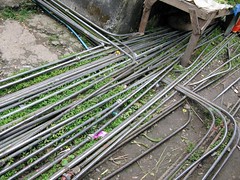February 24, 2010
Twitter is a Low-Bandwidth Multicast Internet
 Photo courtesy of hockadilly |
In the paper "Is it Really About Me? Message Content in Social Awareness Streams" by Mor Naaman, Jeffrey Boase, and Chih-Hui Lai and published in CSCW 2010, the authors look at Twitter messages and attempt characterize what is going on in a representative sample of Twitter users' communication. Personally I believe that Twitter is fundamentally an infrastructure play. I think that "Twitter" is going to become a series of extremely well-engineered pipes that enable people to post information and receive information from an infinite number of streams. It is basically recreating the Internet as something which is based on multi-cast rather than being based on one-to-one connections. Or seen another way they are becoming a new radio spectrum for the Internet. Tune in or tune out as you will. This is phenomenally valuable. It is doing what the Internet did for archival information to ephemeral information. Most analysis, including the one cited above, however, treat Twitter as if it is a consumer grade tool. In my mind, that is like saying that you need to study the water pipes in your neighborhood to see how people are using them. Basically, they use water pipes to get water. There isn't much more to say about it. After that, you are studying what people do with water, not with the infrastructure that delivers it. At this point of course, we've never seen this type of water pipe, so it still makes sense to look at both the pipes and the content. |
This study does this. It doesn't do it naively though. It talks about Twitter as being one of many "social awareness streams" through which people communicate to each other. Then the authors go on to study the content of these streams.
What they found is fascinating. For example, in support of my claim that Twitter is really an infrastructure for ephemeral data, they found that in the random sample of 3379 messages spread across 350 users who were active in Twitter and used it for non-commercial purposes, over 196 different applications were used to put information into Twitter. That blew my mind. I know about 10 applications that post to Twitter but 196 actively used applications, amazed me.
Another fascinating fact, that has also been reported by Pew researchers is that 25% of the posts were from mobile platforms. It think this speaks more to the growth of mobile networks and smart phones than it does about real-time data generation. I suspect that in the same way that phone calls are becoming more and more dominated by mobile connections, Twitter will eventually be almost entirely mobile. That's not the nature of Twitter as much as it's the nature of the future network.
So using open coding methods the authors took the 3379 messages and developed a categorization for them and then had independent coders assign categories to each message for analysis.
The results were that the dominant minority of messages were categorized as "Me Now" messages - messages that described what people were feeling or doing at that moment. Messages were categorized this way 41% of the time. The frequency went up to 51% when you considered just mobile messages.
This lead to an attempt to categorize people into personas which described two types of people, those who were "Informers" - passing links along, or people who were "Meformers" passing their personal context along. The authors left as open work the task of what structural properties of the social graph characterized these two groups.
So although I believe that Twitter is primarily an infrastructure for low-bandwidth multicast, it is still new enough that studies like this one, that characterize emergent ways that people are using it are valuable and informative. It confirmed some of my intuitions, and helped put some numbers to the trends.
Posted by djp3 at February 24, 2010 9:26 AM | TrackBack (0)I don't think it can become infrastructure - it's not an open protocol, its business model has yet been defined, and attrition is astronomically high. A business with negative customer attrition will inevitably fade into obscurity.
Posted by: at February 26, 2010 4:30 AMWhether or not they will succeed at being infrastructure is a business issue and absolutely depends on audience, marketing, usefulness, etc. But the service they are providing from a technical perspective is an infrastructure play.
They are becoming the place to publish and the place to subscribe.
I think a company on the web who doesn't offer something technically new has a much harder time of creating a successful business out of their product.
It is too easy to copy other people and too easy to give something away for free to be viable otherwise.
i think i'm missing something here. what do you mean when you say 'infrastructure for low-bandwidth multicast'? as opposed to what?
Posted by: judy at February 26, 2010 6:13 PMWell, sometimes people saw that Twitter is one thing or another. Like they will say that "Twitter is really just a forum" or "Twitter is really just a way to have a real-time conversation"
Because Twitter, the company, doesn't do very much to guide usage of their system, I think it is more appropriate to identify what Twitter "is" by its technological affordances rather than it's usage model.
So from that perspective I think Twitter is best understood as a company that has taken over publication and distribution of short text messages. RSS feeds separated out those two concerns. Publication and subscription were independent and facilitated by the Internet. Twitter has grabbed both of those functions.
I say it is low-bandwidth because I'm imagining trying to have a radio stream that plays over Twitter. Old-school multicast was all about this. I don't think Twitter could handle many people encoding audio into 140 characters for distribution.
Posted by: Don at March 2, 2010 1:08 PM
